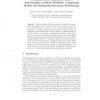Free Online Productivity Tools
i2Speak
i2Symbol
i2OCR
iTex2Img
iWeb2Print
iWeb2Shot
i2Type
iPdf2Split
iPdf2Merge
i2Bopomofo
i2Arabic
i2Style
i2Image
i2PDF
iLatex2Rtf
Sci2ools
110
Voted
MICCAI
2003
Springer
2003
Springer
Statistical Atlas-Based Detection of Abnormalities in Brain Perfusion: Comparing Models and Estimating Detection Performance
Abstract. When developing statistical models of normal brain perfusion, two questions are of crucial interest: How well does an atlas describe normality and how sensitive is it at detecting abnormalities? In this work we attempt to find partial responses to these questions by extensively experimenting with our local database of SPECT images of normal subjects, systematically synthesizing abnormalities and using a leave-one-out scheme to estimate the combined detection and modeling performance. Having such an evaluation framework we are then able to compare different models. We have tested three voxel-based models and we present results showing that a principal component analysis (PCA) model with one or two principal components outperforms a model based uniquely on the voxel-mean and -variance for small abnormalities. A robust version of the PCA model, specially designed for abnormalities of large size, does not bring significant gain over the other methods.
| Added | 15 Nov 2009 |
| Updated | 15 Nov 2009 |
| Type | Conference |
| Year | 2003 |
| Where | MICCAI |
| Authors | Torbjørn Vik, Fabrice Heitz, Jean-Paul Armspach |
Comments (0)

